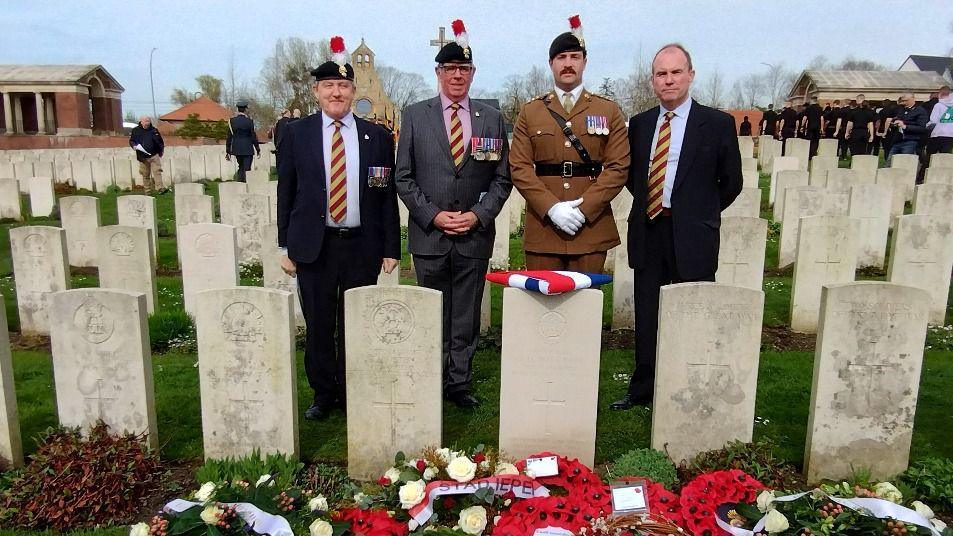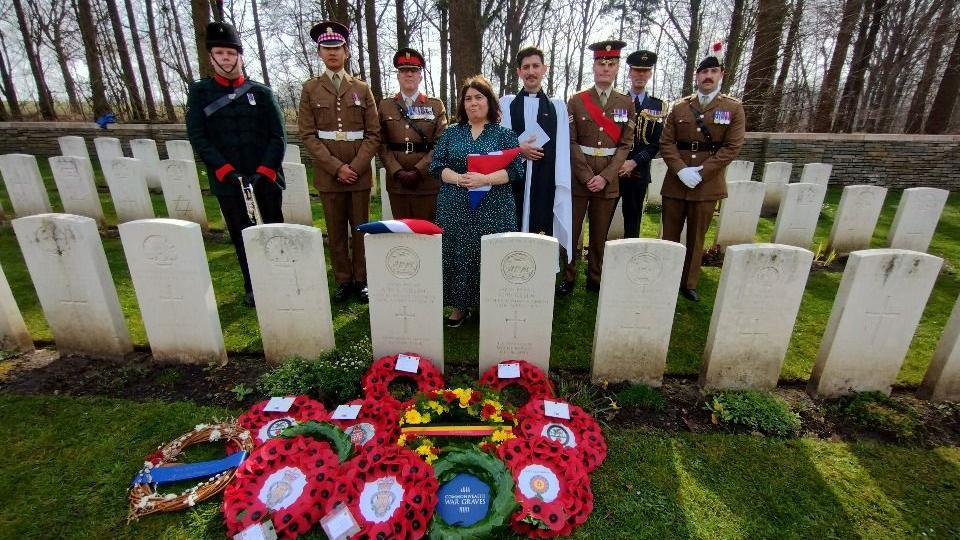World War One soldiers' unmarked graves identified

Members of the Royal Regiment of Fusiliers stand by Sgt John Harold Bott's grave
- Published
The unmarked graves of three World War One soldiers have been identified more than 100 years after their deaths.
The final resting places of Sgt John Harold Bott, from Longton, Stoke-on-Trent, Pte Charles Green, from London, and Pte Albert Culling from Taunton, Somerset, were rededicated at ceremonies held in Belgium.
All three had been killed in action while on deployment in Belgium during the summer of 1917 and were buried in unmarked graves as their bodies could not be identified.
Sgt Bott’s grave is located at the Hooge Crater Cemetery in Ypres, while Pte Green and Pte Culling are buried in the Buttes New British Cemetery at Polygon Wood in Zonnebeke.
Sgt John Harold Bott
Born in 1896 and one of four brothers, Sgt Bott was working as a hairdresser’s apprentice before he enlisted in 1914, joining the 11th Battalion the Royal Fusiliers (City of London Regiment).
Before his death, he had fought and been wounded in the Somme in the summer of 1916, after which he was awarded the Distinguished Conduct Medal for leading a bombing party that captured an enemy machine gun.
During the Third Battle of Ypres, Sgt Bott’s squad took part in an attack on Westhoek Ridge on 10 August 1917 but they were halted by heavy machine gun fire.
Sgt Bott, aged 21, was killed as the rest of the battalion was pushed back when the enemy launched a counterattack.
His body was recovered after the war and he was buried as an unknown soldier at Hooge Crater Cemetery.
His grave was identified after research was carried out by the Commonwealth War Graves Commission (CWGC), the National Army Museum and the Joint Casualty and Compassionate Centre (JCCC).
His rededication ceremony was held at the cemetery with members of the Royal Regiment of Fusiliers in attendance.
JCCC caseworker Rosie Barron said he had lost his life in one of the most horrific battles in history, adding that it was an honour to have played a part in identifying his grave.

Kelly Salter, great niece of Pte Green, attended the ceremony
Pte Culling and Pte Green
Pte Culling and Pte Green were both part of the 1/24th London Regiment and entered the frontline trenches near Westhoek on 24 August 1917.
Diary records showed that the trenches were subjected to episodes of shelling on 25 and 26 August, including a 90-minute artillery bombardment at 23:00 on 25 August, killing three and wounding 14.
Pte Culling and Pte Green were two of the three men who were killed but could only be identified as members of the battalion via their regimental insignia.
They were buried in a shared field grave until March 1920 when they were relocated and buried next to each other at Buttes New British Cemetery.
JCCC Caseworker Alexia Clark said she was grateful to the researcher for their work in identifying the graves.
The rededication service at the cemetery was attended by members of Pte Green’s family, including his great niece Kelly Salter.
Follow BBC West Midlands on Facebook, external, X, external and Instagram, external. Send your story ideas to: newsonline.westmidlands@bbc.co.uk, external